Chapter VI — Winter among the Mandans
Before finally selecting the spot on which to build their winter quarters, Lewis and Clark held councils with the chiefs of the tribes who were to be their neighbors during the cold season. These were Mandans, Annahaways, and Minnetarees, tribes living peacefully in the same region of country. The principal Mandan chief was Black Cat; White Buffalo Robe Unfolded represented the Annahaways, and the Minnetaree chief was Black Moccasin. This last-named chief could not come to the council, but was represented by Caltahcota, or Cherry on a Bush. The palaver being over, presents were distributed. The account says:—
“One chief of each town was acknowledged by a gift of a flag, a medal with the likeness of the President of the United States, a uniform coat, hat and feather. To the second chiefs we gave a medal representing some domestic animals and a loom for weaving; to the third chiefs, medals with the impressions of a farmer sowing grain. A variety of other presents were distributed, but none seemed to give them more satisfaction than an iron corn-mill which we gave to the Mandans. . . .
“In the evening the prairie took fire, either by accident or design, and burned with great fury, the whole plain being enveloped in flames. So rapid was its progress that a man and a woman were burned to death before they could reach a place of safety; another man, with his wife and child, were much burned, and several other persons narrowly escaped destruction. Among the rest, a boy of the half white breed escaped unhurt in the midst of the flames; his safety was ascribed to the great medicine spirit, who had preserved him on account of his being white. But a much more natural cause was the presence of mind of his mother, who, seeing no hopes of carrying off her son, threw him on the ground, and, covering him with the fresh hide of a buffalo, escaped herself from the flames. As soon as the fire had passed, she returned and found him untouched, the skin having prevented the flame from reaching the grass on which he lay.”
Next day, says the journal,—




